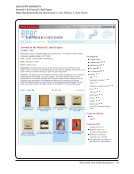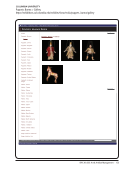12 · Survey Results: Executive Summary
for the continuing stewardship of art and artifact col-
lections in our care.
The survey focused on the systems and techniques
used to manage physical art and artifact materials
in order to insure intellectual control over them. For
the purposes of this survey, art and artifact materials
were considered separately in order to determine if
there are differences between the management of
these types of materials. Art objects include paint-
ings, works on paper, prints, art photographs, sculp-
ture, decorative arts, or graphic design. Artifacts were
defined as including historic photographs, historic
objects, material culture, merchandise, archeological
objects, natural history specimens, costumes, and ar-
chitectural drawings, designs, and models. Of course,
there are objects that might fall into either category,
so respondents were asked to make a determination
based on the nature and purpose of their specific
collections. Recognizing that many institutions have
multiple individually managed special collections,
respondents were invited to submit a response for
each one.
Sixty-eight libraries at 53 of the 126 ARL member
libraries submitted a survey between April 16 and
May 7 for a response rate of 42%. Data from these
respondents confirms that ARL member institu-
tions collect large numbers of art objects and arti-
facts, sometimes intentionally, but often incidentally.
Practices for managing and providing access to these
materials vary widely both within individual special
collections and institutions and across the entire com-
munity, with no universally accepted standard, tool,
or techniques.
Scale and Scope of Art and Artifact Collections
Fifty-nine of the 68 responding libraries (87%) reported
holding art objects and 62 (91%) reported holding ar-
tifacts. The variety of the types of art and artifacts
is broad: prints are included in 92% of the libraries’
collections paintings in 87%, works on paper in 83%,
and sculpture and art photographs in 65% each. The
most commonly mentioned type of art object for the
category “other” was artists’ books. When it comes to
artifacts, respondents report similarly high numbers
and variety: 97% of respondents’ collections contain
historic photographs, 84% historical objects, and 75%
contain material culture and architectural drawings,
designs, and models. All the types of artifacts listed
in the survey received positive responses the small-
est number was natural history specimens with 12
respondents (19%). The items cited under “other” in-
dicate that almost anything can be found in a special
collection somewhere, from the typical (ephemera,
toys, souvenirs, medals) to the truly unusual and un-
expected (locks of hair, condoms, death masks).
The quantity is also impressive. Although 40% of
responding libraries said they have fewer than 500
works of art, over a third (22 respondents, or 37%)
reported owning more than 5,000, with nine of those
(15%) owning more than 25,000. Not surprisingly,
artifacts were even more numerous, with only eight
libraries (13%) reporting fewer than 500 artifacts in
their collections, while over half (33, or 52%) have
more than 5,000. The holdings of more than a third of
those exceed 25,000 artifacts and, based on the com-
ments received, several actually number in the mil-
lions. This data might suggest that most respondents
collect art and artifacts intentionally, although four
respondents commented that artworks were acquired
haphazardly or incidentally as part of larger collec-
tions and one said the same for artifacts.
Tools for Managing Art and Artifacts
The authors considered several hypotheses about the
tools that libraries might use to manage their holdings
of art and artifacts. As libraries use their library cata-
logs to describe books, journals, and other resources
at the item level, one speculation was that libraries
might be using their integrated library systems (ILS) to
describe art works, since these are typically described
at the item level. On the other hand, the authors’ expe-
rience suggested that artifacts often come to libraries
in the context of archival collections the hypothesis
being that these materials would be treated as such,
and probably described in finding aids. The authors
also speculated that many institutions would use more
than one tool.
The survey gave the following options for tools
believed to be commonly used: MARC records in an
Integrated Library System (library catalog) Museum
collections management system such as PastPerfect
Archival management system such as Archivists’
for the continuing stewardship of art and artifact col-
lections in our care.
The survey focused on the systems and techniques
used to manage physical art and artifact materials
in order to insure intellectual control over them. For
the purposes of this survey, art and artifact materials
were considered separately in order to determine if
there are differences between the management of
these types of materials. Art objects include paint-
ings, works on paper, prints, art photographs, sculp-
ture, decorative arts, or graphic design. Artifacts were
defined as including historic photographs, historic
objects, material culture, merchandise, archeological
objects, natural history specimens, costumes, and ar-
chitectural drawings, designs, and models. Of course,
there are objects that might fall into either category,
so respondents were asked to make a determination
based on the nature and purpose of their specific
collections. Recognizing that many institutions have
multiple individually managed special collections,
respondents were invited to submit a response for
each one.
Sixty-eight libraries at 53 of the 126 ARL member
libraries submitted a survey between April 16 and
May 7 for a response rate of 42%. Data from these
respondents confirms that ARL member institu-
tions collect large numbers of art objects and arti-
facts, sometimes intentionally, but often incidentally.
Practices for managing and providing access to these
materials vary widely both within individual special
collections and institutions and across the entire com-
munity, with no universally accepted standard, tool,
or techniques.
Scale and Scope of Art and Artifact Collections
Fifty-nine of the 68 responding libraries (87%) reported
holding art objects and 62 (91%) reported holding ar-
tifacts. The variety of the types of art and artifacts
is broad: prints are included in 92% of the libraries’
collections paintings in 87%, works on paper in 83%,
and sculpture and art photographs in 65% each. The
most commonly mentioned type of art object for the
category “other” was artists’ books. When it comes to
artifacts, respondents report similarly high numbers
and variety: 97% of respondents’ collections contain
historic photographs, 84% historical objects, and 75%
contain material culture and architectural drawings,
designs, and models. All the types of artifacts listed
in the survey received positive responses the small-
est number was natural history specimens with 12
respondents (19%). The items cited under “other” in-
dicate that almost anything can be found in a special
collection somewhere, from the typical (ephemera,
toys, souvenirs, medals) to the truly unusual and un-
expected (locks of hair, condoms, death masks).
The quantity is also impressive. Although 40% of
responding libraries said they have fewer than 500
works of art, over a third (22 respondents, or 37%)
reported owning more than 5,000, with nine of those
(15%) owning more than 25,000. Not surprisingly,
artifacts were even more numerous, with only eight
libraries (13%) reporting fewer than 500 artifacts in
their collections, while over half (33, or 52%) have
more than 5,000. The holdings of more than a third of
those exceed 25,000 artifacts and, based on the com-
ments received, several actually number in the mil-
lions. This data might suggest that most respondents
collect art and artifacts intentionally, although four
respondents commented that artworks were acquired
haphazardly or incidentally as part of larger collec-
tions and one said the same for artifacts.
Tools for Managing Art and Artifacts
The authors considered several hypotheses about the
tools that libraries might use to manage their holdings
of art and artifacts. As libraries use their library cata-
logs to describe books, journals, and other resources
at the item level, one speculation was that libraries
might be using their integrated library systems (ILS) to
describe art works, since these are typically described
at the item level. On the other hand, the authors’ expe-
rience suggested that artifacts often come to libraries
in the context of archival collections the hypothesis
being that these materials would be treated as such,
and probably described in finding aids. The authors
also speculated that many institutions would use more
than one tool.
The survey gave the following options for tools
believed to be commonly used: MARC records in an
Integrated Library System (library catalog) Museum
collections management system such as PastPerfect
Archival management system such as Archivists’


















































































































































































